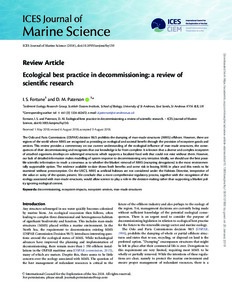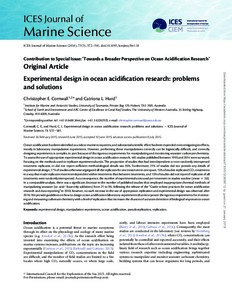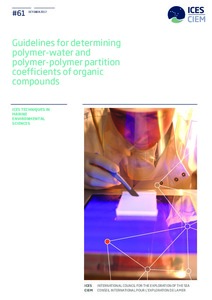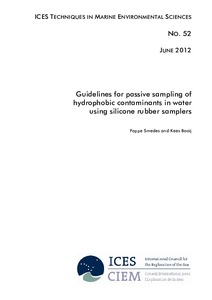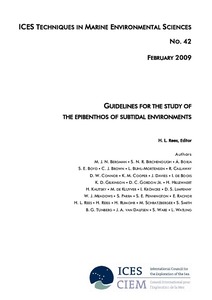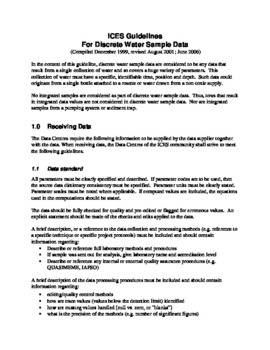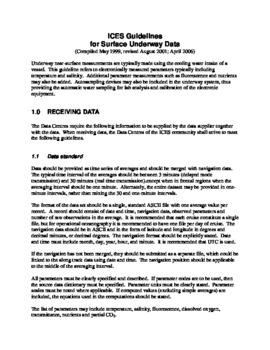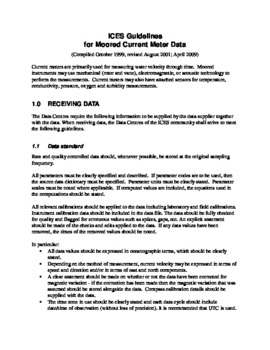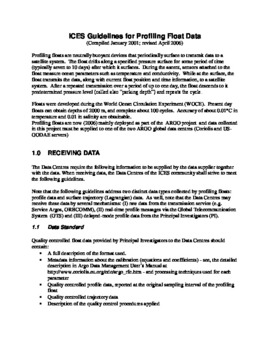Browsing ⇒ ICES: International Council for the Exploration of the Sea by Title
Now showing items 41-60 of 90
-
Ecological best practice in decommissioning: a review of scientific research.
(2018)The Oslo and Paris Commissions (OSPAR) decision 98/3 prohibits the dumping of man-made structures (MMS) offshore. However, there are regions of the world where MMS are recognized as providing an ecological and societal ... -
Experimental design in ocean acidification research: problems and solutions.
(2016)Ocean acidification has been identified as a risk to marine ecosystems, and substantial scientific effort has been expended on investigating its effects, mostly in laboratory manipulation experiments. However, performing ... -
Guidelines for determining polymer-water and polymer-polymer partition coefficients of organic compounds.
(International Council for the Exploration of the Sea (ICES), Copenhagen, Denmark, 2017)Methods for the experimental determination of polymer-water partition coefficients (Kpw) and polymer-polymer partition coefficients (Kp1p2) are reviewed with the aim to improve the quality of passive sampling-based monitoring ... -
Guidelines for passive sampling of hydrophobic contaminants in water using silicone rubber samplers.
(International Council for the Exploration of the Sea (ICES), Copenhagen, Denmark, 2012)This ICES Techniques in Marine Environmental Sciences provides advice on the use of silicone rubber passive samplers for the determination of freely dissolved non‐polar contaminants in seawater. The level of detail offered ... -
Guidelines for the study of the epibenthos of subtidal environments.
(International Council for the Exploration of the Sea (ICES), Copenhagen, Denmark, 2009)These Guidelines for the Study of the Epibenthos of Subtidal Environments document a range of sampling gears and procedures for epibenthos studies that meet a variety of needs. The importance of adopting consistent sampling ... -
Handbook of fish age estimation protocols and validation methods.
(International Council for the Exploration of the Sea (ICES), Copenhagen, Denmark, 2019)The Planning Group on Commercial Catch, Discards and Biological Sampling (PGCCDBS) 2012 was approached by the ICES Publications and Communications Group (PUBCOM) with the suggestion to combine the existing protocols on ... -
Handbook of geo-statistics in R for fisheries and marine ecology.
(International Council for the Exploration of the Sea (ICES), Copenhagen, Denmark, 2017)Fisheries surveys to estimate the abundance of populations have become a pillar in providing fishery-independent data to determine the status of fish stocks and monitor ecosystems. Since the early 1990s, ... -
Hydrocarbons: Review of methods for analysis in sea water, biota, and sediments.
(International Council for the Exploration of the Sea (ICES), Copenhagen, Denmark, 1991)The overview presented in the following paragraphs is not a collection of analytical procedures in the sense of a 'cookbook'. It is intended as an introduction to the subject and a collecti ... -
ICES Data Guidelines for Discrete Water Samples. (Compiled December 1999, revised August 2001; June 2006) .
(International Council for the Exploration of the Sea (ICES), Copenhagen, Denmark, 2006)In the context of this guideline, discrete water sample data are considered to be any data that result from a single collection of water and so cover s a huge variety of parameters. This collection of water must have ... -
ICES Data Guidelines for Seasoar (Batfish) data. (Compiled May 1999, revised August. 2001; December 2006)
(International Council for the Exploration of the Sea (ICES), Copenhagen, Denmark, 2006)The Seasoar (or Batfish) instrument is a towed platform typically equipped with a CTD. Other sensors, such as fluorometers or transmissometers, ma y also be added. The SeaSoar has hydraulically controlled wings, ... -
ICES Data Guidelines for Shipboard ADCP data. (Compiled May 1999; revised April 2006)
(International Council for the Exploration of the Sea (ICES), Copenhagen, Denmark, 2006)ADCPs (acoustic doppler current profiler) were first introduced to the oceanography community in the late 1970s (Rowe and Young, 1979). The instrument measures water veloc ity over a range of depths using doppler ... -
ICES Data Guidelines for Surface Underway Data. (Compiled December 1999, revised August 2001; May 2006) .
(International Council for the Exploration of the Sea (ICES), Copenhagen, Denmark, 2006)Underway near - surface measurements are typically made using the cooling water intake of a vessel. This guideline refers to electronically measured parameters typically including temperature and salinity. ... -
ICES Guidelines for Moored ADCP data. (Compiled October 1999; revised August 2001; August 2006)
(International Council for the Exploration of the Sea (ICES), Copenhagen, Denmark, 2006)ADCPs (acoustic doppler current profiler) were first introduced to the oceanography community in the late 1970s (Rowe and Young, 1979). The instrument measure s water velocity over a range of depths using doppler ... -
ICES Guidelines for Moored Current Meter data. (Compiled October 1999; revised August 2001; April 2009)
(International Council for the Exploration of the Sea (ICES), Copenhagen, Denmark, 2009)Current meters are primarily used for measuring water velocity through time. Moored instruments may use mechanical (rotor and vane), electromagmetic, o r acoustic technology to perform the measurements. Current ... -
ICES Guidelines for Benchmarks. Version 1.
(International Council for the Exploration of the Sea (ICES), Copenhagen, Denmark, 2023)The guidelines describe the principles, elements, purpose, types, and prioritization of ICES benchmarks. The information in this document is relevant for the ICES expert groups delivering scientific evidence for benchmark ... -
ICES Guidelines for Biological Plankton data. (Compiled August 2001; reviewed April 2006)
(International Council for the Exploration of the Sea (ICES), Copenhagen, Denmark, 2006)In the context of this guideline, phytoplankton or zooplankton sampling may be accomplished using either a vertical, horizontal or oblique tow of a net or from a ro sette bottle. In the case of a net, such a device ... -
ICES Guidelines for CTD data. (Compiled March 2000; revised August 2001; June 2006)
(International Council for the Exploration of the Sea (ICES), Copenhagen, Denmark, 2006)CTD (conductivity, temperature and depth) instruments were introduced to the oceanography community in the late 1960's. Since then, the electronic measurement of conduct ivity, temperature and pressure provided by ... -
ICES Guidelines for Multibeam Echosounder data. (Compiled September 2006)
(International Council for the Exploration of the Sea (ICES), Copenhagen, Denmark, 2006)If you are considering producing a hydrographic survey please read the following information first. Your survey could be used to compile new or updated nautical charts and so help i mprove safety for mariners.Your ... -
ICES Guidelines for Profiling Float data. (Compiled January 2001; revised April 2006)
(International Council for the Exploration of the Sea (ICES), Copenhagen, Denmark, 2006)Profiling floats are neutrally buoyant devices that periodically surface to transmit data to a satellite system. The float drifts along a specified pressure surface for some period of time (typically seven to 10 days) ... -
ICES Guidelines for Surface Drifting Buoy data. (Compiled March 20001; revised August 2006)
(International Council for the Exploration of the Sea (ICES), Copenhagen, Denmark, 2006)Drifting buoys (UNESCO, 1988) have a long history of use in oceanography, starting in late 1978 with the First GARP Global Experiment (FGGE), principally for the mea surement of currents by following the motions of ...
 Repository of community practices in Ocean Research, Applications and Data/Information Management
Repository of community practices in Ocean Research, Applications and Data/Information Management
